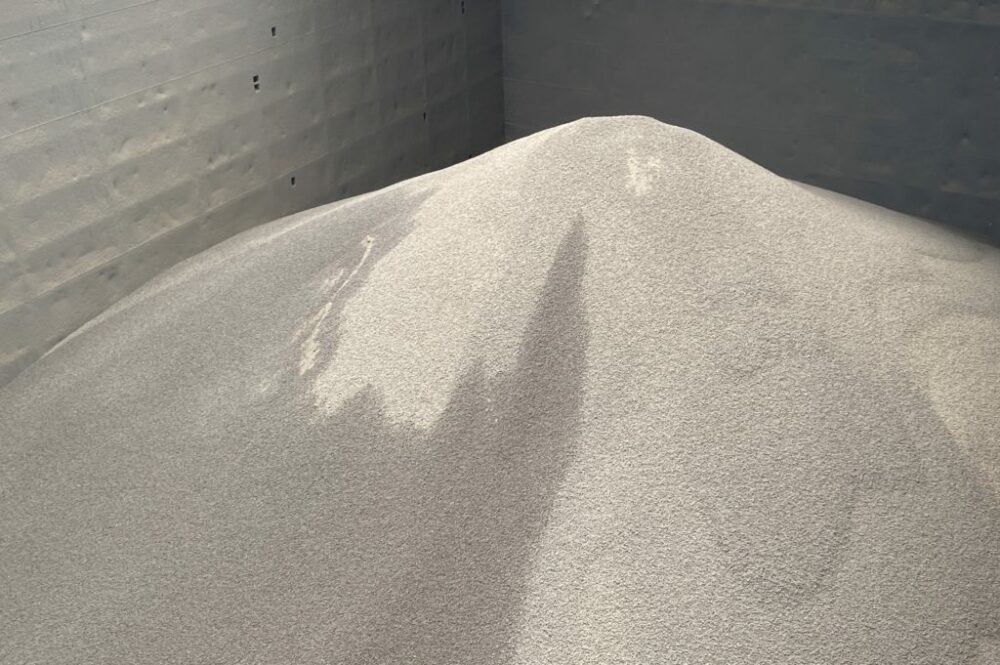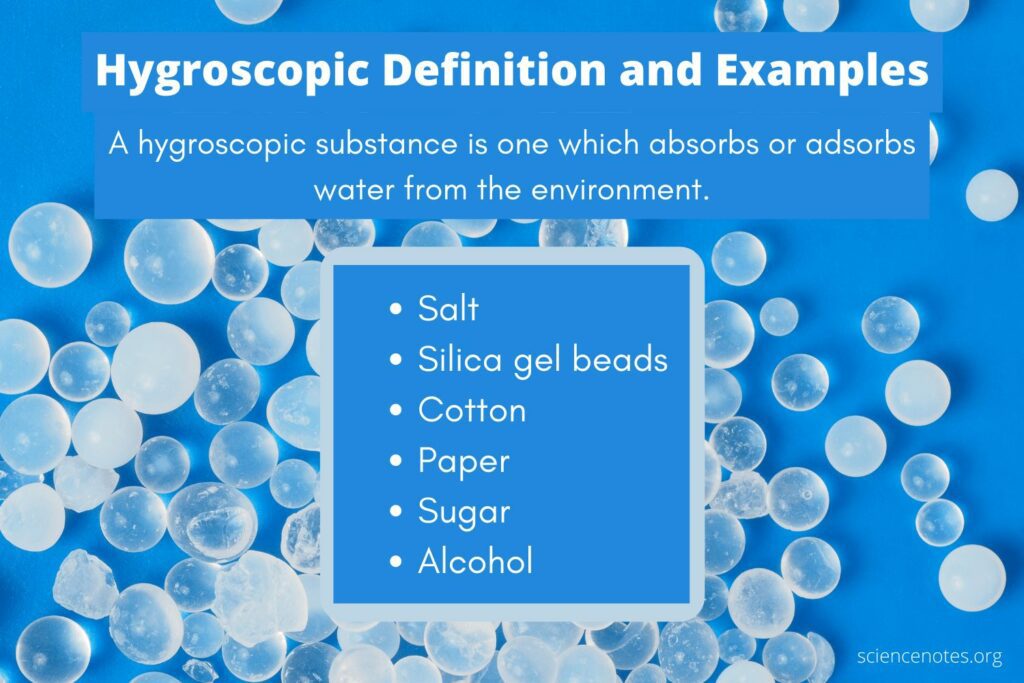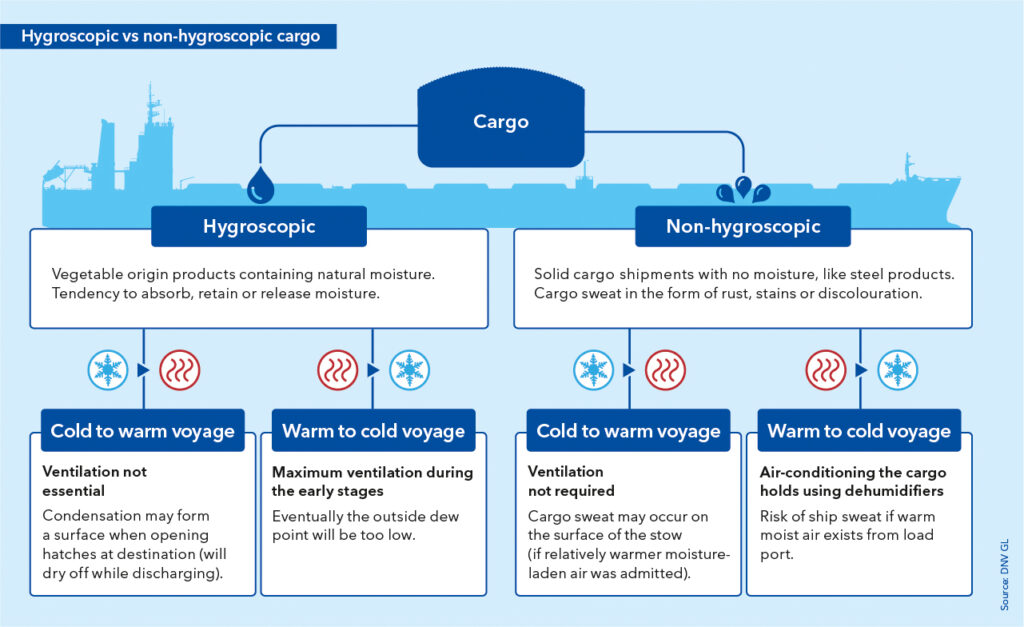An important aspect of transporting cargo by ship is the prevention of damage to the cargo and the avoidance of its consequential claims.
Because moisture is the source of a significant number of cargo claims on board ships, knowledge of how cargoes are affected by moisture is very useful to ship officers. Basis susceptibility to moisture, cargo is classified as either hygroscopic or non-hygroscopic.
Hygroscopic cargo is cargo that absorbs moisture from the air, non-hygroscopic cargo does not.
The ability of a product (such as cargo or packaging material) to react to the moisture content of the air by collecting or releasing water vapor is known as hygroscopicity.
Several factors that can originate from the physical and chemical properties of the cargo itself, or from changing temperature and air humidity conditions can compromise the integrity of cargo during normal transit.
This write-up explains what hygroscopic and non-hygroscopic cargoes are, and the importance of knowing the difference.
What is Hygroscopic Cargo?
There are many types of cargo that can be transported by ship. One of the most important types is hygroscopic cargo. The term hygroscopic cargo refers to a type of cargo that is susceptible to moisture loss or gain, because of changes in ambient relative humidity. This type of cargo is typically delicate, perishable, or otherwise temperature-sensitive.
Hygroscopic items are mostly of plant origin and contain a natural moisture content. Excessive quantities of inherent moisture may cause substantial self-heating and “moisture migration” within this type of cargo, which can result in caking, mildew, or rot.
Typical hygroscopic cargoes include dried fruits and vegetables, flowers, and pharmaceuticals. Here is a list of 10 examples of hygroscopic cargo:
- Salt
- Sugar
- Coffee beans
- Grains (such as wheat, corn, and rice)
- Dried fruits (such as raisins, dates, and apricots)
- Nuts (such as almonds, peanuts, and cashews)
- Cocoa beans
- Tea leaves
- Tobacco leaves
- Potassium chloride (also known as muriate of potash)
- Cotton
- Silica gel beads
- Paper

Hygroscopic cargoes may often have inherent moisture levels that exceed acceptable limits at the time of loading, making them biologically unstable. They, therefore, become vulnerable to damage during transit, as they are often exposed to fluctuations in temperature and humidity as the ship moves through different climatic zones. As such, it is important for shippers and logistics providers to take measures to protect these cargoes.
Why is It Important To Know The Difference?
Knowing the difference between these two types of cargo is important for anyone who works with or handles these materials. By understanding the risks and dangers associated with hygroscopic cargo, you can take steps to avoid these problems. For example, hygroscopic cargo is more prone to absorb moisture from the air, which can lead to weight gain and the potential for the cargo to deteriorate.

Additionally, the way they are stowed and transported can vary. For example, hygroscopic cargo must be stowed in a manner that permits its environment to be monitored and, if possible, controlled to maintain its quality. Non-hygroscopic cargo on the other hand can be stowed in any type of container.
What are the Dangers of Hygroscopic Cargo?
Hygroscopic cargo is a type of cargo that absorbs moisture from the air. This can lead to a number of problems, such as rust, decay, and mold. In some cases, such cargo can even be dangerous, for example, if hygroscopic cargo absorbs too much moisture, it can become unstable and might potentially become explosive.
Because of the dangers associated with hygroscopic cargo, it is important to take precautions when shipping and stowing this type of cargo. Make sure to keep hygroscopic cargo in a dry, well-ventilated area, and if you are transporting hygroscopic cargo, be sure to do so in a closed container that is designed to keep moisture out.
When shipping hygroscopic cargo, it is important to be aware of the potential dangers that can occur. If the cargo is not properly sealed or protected, it can absorb moisture from the air and become damaged.
This can lead to the cargo becoming moldy or rotten, and that can pose a serious health hazard. In addition, hygroscopic cargo can also become infested with insects if it is not properly protected.
To avoid these dangers, it is important to take proper precautions when shipping this type of cargo. The cargo should be properly sealed and protected from the elements. In addition, the cargo should be inspected regularly to ensure that it has not been damaged by moisture or insects.
Protecting Hygroscopic Cargo During Transport.
Hygroscopic cargo can be damaged by exposure to high humidity levels. This type of cargo must be carefully protected during transport to ensure that it arrives at its destination in good condition. There are a few different ways to protect hygroscopic cargo during transport.
One common method is to use a desiccant, which is a substance that absorbs moisture from the air. Using a desiccant helps to keep the moisture levels down and protect the cargo from mold growth. Another way to protect hygroscopic cargo is to ship it in a controlled atmosphere. This is often done with food shipments, as it can prevent the food from spoilage.
Whatever method you choose to protect your hygroscopic cargo, it is important that you take the time to examine all viable options and make sure every part of your method is working before sending the products out. Combined with proper labeling, storage in a cool, dry area, and general transportation best practices, these tips will help keep your hygroscopic goods safe during transit.
What is Non-hygroscopic Cargo?
Non-hygroscopic cargo is goods that are resistant to moisture and do not absorb moisture from the atmosphere. Cargoes such as metals, rubber, glass, some types of plastics, and some types of dried food can be classified as non-hygroscopic.

Non-hygroscopic cargoes have several advantages over hygroscopic cargoes. They are less likely to be damaged by moisture and are also easier to stow and transport. Non-hygroscopic cargo is less likely to spoil or go bad.
Good examples of typical non-hygroscopic cargoes:
- Coal
- Iron ore
- Bauxite
- Lime
- Steel pellets
- Steel
- Timber
- Rubber
- Aluminum
Protecting Non-hygroscopic Cargo During Transport.
Cargo that is not hygroscopic although might not give off moisture is still susceptible to damage from outside moisture coming in contact with it during transport. This can lead to mold and mildew growth, as well as deterioration of the cargo itself. To protect non-hygroscopic cargo during transport, it is important to take the following steps:
- Keep the cargo dry. This is the most important step in protecting non-hygroscopic cargo. Make sure that the cargo area is well-ventilated in the cargo hold and dry before loading the cargo. If possible, cover the cargo with a tarp or other waterproof material to further protect it from moisture.
- Monitor the humidity: If possible, monitor the humidity levels during transport. If the humidity levels get too high, it can lead to condensation on the cargo, which can then lead to mold and mildew growth.
- Keep the cargo cool: If possible, keep the cargo area cool during transport. This will help to prevent moisture from condensing on the cargo.
By taking these steps, you can help to protect your non-hygroscopic cargo during transport and ensure that it arrives at its destination in good condition.
Conclusion.
Mold and mildew, the result of moisture damage, can affect all cargo and its packaging, which can be a particularly nasty problem for organic cargo like food or agricultural commodities. To make matters worse, moisture damage can also affect the smell and taste of food or invite bugs, which even less fussy eaters get picky about.
These all make the subject of hygroscopicity very important in transporting goods at sea because whether or not a consignment of cargo is hygroscopic, there is always a chance that, if the proper precautions are not taken, moisture damage can occur.
- Types of Gas Carriers as per IGC Code – April 22, 2025
- Wind-Assisted Propulsion Systems (WAPS): A Game Changer for Maritime Decarbonization – February 6, 2025
- 10 Boat Salvage Yards in California – January 25, 2025




